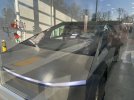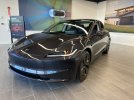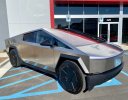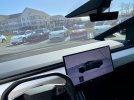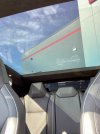I'm betting that if you live in California you won't have control of when they use your car as a power source. You're just one of the Borg.They're not saying the batteries are the primary power source, rather that they can eliminate primary power sources other than wind and solar, while solving problems with California's fragile electrical grid. Overlooking that wind and solar only meet 1/3 of California's electrical needs, and that same fragile grid would still be needed to move power to and from the EVs.
Some quotes from the link are below:
Nancy Skinner’s bill, SB233. This legislation will require most new electric vehicles sold in California to be bidirectional by 2035, laying the foundation for EVs to power homes and businesses, lower our energy bills, clean the air and make the electricity grid more reliable.
With millions of EV batteries storing abundant clean energy during the day and sending that power back to the grid during peak hours, we can finally say goodbye to gas plants and the thousands of noisy, dirty diesel generators that have been purchased in recent years. (Uh...peak hours are during the day)
Even better, EVs are “batteries on wheels” that can be moved where they’re needed most during heat waves, fires and associated power shutoffs, like backing up hospitals, schools, fire stations and community cooling centers.
What’s more, making EVs bidirectional typically costs only a few hundred dollars per vehicle and gives owners a chance to save on their electricity bills, so it won’t put electric cars out of reach for middle-income and low-income families. (the economic logic of that was well-captured by the graphic @Bob Noel posted above)
You are using an out of date browser. It may not display this or other websites correctly.
You should upgrade or use an alternative browser.
You should upgrade or use an alternative browser.
Tesla Pickup Unveil
- Thread starter FastEddieB
- Start date
DaleB
Final Approach
More proof that CA's abundant supply of imported drugs is getting put to good use.They're not saying the batteries are the primary power source, rather that they can eliminate primary power sources other than wind and solar, while solving problems with California's fragile electrical grid. Overlooking that wind and solar only meet 1/3 of California's electrical needs, and that same fragile grid would still be needed to move power to and from the EVs.
Some quotes from the link are below:
Nancy Skinner’s bill, SB233. This legislation will require most new electric vehicles sold in California to be bidirectional by 2035, laying the foundation for EVs to power homes and businesses, lower our energy bills, clean the air and make the electricity grid more reliable.
With millions of EV batteries storing abundant clean energy during the day and sending that power back to the grid during peak hours, we can finally say goodbye to gas plants and the thousands of noisy, dirty diesel generators that have been purchased in recent years. (Uh...peak hours are during the day)
Even better, EVs are “batteries on wheels” that can be moved where they’re needed most during heat waves, fires and associated power shutoffs, like backing up hospitals, schools, fire stations and community cooling centers.
What’s more, making EVs bidirectional typically costs only a few hundred dollars per vehicle and gives owners a chance to save on their electricity bills, so it won’t put electric cars out of reach for middle-income and low-income families. (the economic logic of that was well-captured by the graphic @Bob Noel posted above)
- Joined
- Jun 7, 2008
- Messages
- 24,110
- Display Name
Display name:
Bob Noel
Put to use, I’m not sure “good use”More proof that CA's abundant supply of imported drugs is getting put to good use.
Katamarino
Pattern Altitude
I read his statements as being that they can eliminate/reduce dirty "peaker" plants if they have a lot more grid-attached storage - which is entirely true and sensible.
ElPaso Pilot
En-Route
- Joined
- May 26, 2006
- Messages
- 2,512
- Display Name
Display name:
ElPaso Pilot
EV owners will need to be incentivized properly for the program to work.
If someone want to make a buck off of their vehicle by buying cheap power overnight and selling it back at a profit during the day, why not?

 driivz.com
driivz.com
If someone want to make a buck off of their vehicle by buying cheap power overnight and selling it back at a profit during the day, why not?
The right business models can incentivize adoption
People and businesses buy vehicles for transportation, not to serve as grid assets. Although drivers may value having a way to reduce carbon footprint, save money, and participate in stopping climate change, the right business models are also key to V2G adoption.
For individual EV owners, time-of-use pricing is an effective money-saving incentive for shifting grid consumption to off-peak hours. It can also pave the way for consumer participation in energy arbitrage, which provides actual revenue through buying low and selling high. Rebates and tax credits to offset the up-front costs of buying and installing bidirectional charging equipment are also key.
Fleet operators can realize cost savings through optimized charging and discharging schedules and generate revenue by taking advantage of dynamic pricing, energy arbitrage, and demand response programs. Establishing these programs in a timely manner will require utilities and regulators to both be on board.

California Bill: Mandates Bidirectional V2G Charging | Driivz
Learn about SB-233, the California bill aiming to mandate bidirectional V2G charging for EVs
 driivz.com
driivz.com
- Joined
- Jul 21, 2014
- Messages
- 9,827
- Location
- Broken Arrow, OK
- Display Name
Display name:
SoonerAviator
Because they will put a cap on profits from it, and because putting more battery cycles on the vehicle just wears out the battery more quickly and results in accelerated depreciation of the car. There's not a chance I'd sign up for anything like that. However, I'm not a "Cali" kind of guy.EV owners will need to be incentivized properly for the program to work.
If someone want to make a buck off of their vehicle by buying cheap power overnight and selling it back at a profit during the day, why not?
The right business models can incentivize adoptionPeople and businesses buy vehicles for transportation, not to serve as grid assets. Although drivers may value having a way to reduce carbon footprint, save money, and participate in stopping climate change, the right business models are also key to V2G adoption.For individual EV owners, time-of-use pricing is an effective money-saving incentive for shifting grid consumption to off-peak hours. It can also pave the way for consumer participation in energy arbitrage, which provides actual revenue through buying low and selling high. Rebates and tax credits to offset the up-front costs of buying and installing bidirectional charging equipment are also key.Fleet operators can realize cost savings through optimized charging and discharging schedules and generate revenue by taking advantage of dynamic pricing, energy arbitrage, and demand response programs. Establishing these programs in a timely manner will require utilities and regulators to both be on board.

California Bill: Mandates Bidirectional V2G Charging | Driivz
Learn about SB-233, the California bill aiming to mandate bidirectional V2G charging for EVsdriivz.com
OneCharlieTango
Cleared for Takeoff
- Joined
- Dec 21, 2018
- Messages
- 1,165
- Display Name
Display name:
OneCharlieTango
I have a truck. I use it for truck things occasionally, but mostly I really do look cooler in it than I did in my Subaru or my BMW, or my wife’s Honda Fit or Odyssey minivan.
I don’t understand the criticism of those who have but don’t “need” trucks. So what? I bought it for myself, and my family likes it. I have, but don’t need, 3000 square feet of house, running shoes, a three car garage or. . . .let’s see, there’s something else I own that I don’t need. . . . .oh, yeah - an AIRPLANE!
I don’t understand the criticism of those who have but don’t “need” trucks. So what? I bought it for myself, and my family likes it. I have, but don’t need, 3000 square feet of house, running shoes, a three car garage or. . . .let’s see, there’s something else I own that I don’t need. . . . .oh, yeah - an AIRPLANE!
Larry in TN
En-Route
Grid backup is relatively easy on the batteries as the rate of charge/discharge is low and produces very little heat. Still, whole-house battery backups, like the Powerwall and similar products, likely have a bigger future in the distributed grid backup future. The advantage to using EVs as well is that there will likely be a more EVs connected to the grid than home battery backups.Because they will put a cap on profits from it, and because putting more battery cycles on the vehicle just wears out the battery more quickly and results in accelerated depreciation of the car. There's not a chance I'd sign up for anything like that. However, I'm not a "Cali" kind of guy.
- Joined
- Jul 21, 2014
- Messages
- 9,827
- Location
- Broken Arrow, OK
- Display Name
Display name:
SoonerAviator
Sure, but cycles are cycles and depreciation is there. If your EV is being drawn down 10-15% each day because the utility needed your reserve power, it takes its toll. It'd make as much sense to just take excess power generation and pump water up a hill to be recovered later when power is needed. Geothermal, battery banks, whatever. The parasitic loss of energy using thousands of EVs connected to the grid versus a few, centralized power banks is probably not insignificant.Grid backup is relatively easy on the batteries as the rate of charge/discharge is low and produces very little heat. Still, whole-house battery backups, like the Powerwall and similar products, likely have a bigger future in the distributed grid backup future. The advantage to using EVs as well is that there will likely be a more EVs connected to the grid than home battery backups.
Larry in TN
En-Route
If "cycles are cycles", why is frequent fast charging harder on the battery than slower Level II charging? Heat.Sure, but cycles are cycles and depreciation is there.
Why can batteries that no longer useful in cars still work find in grid-level backup? Power transfer speed.
It'll depend on how much credit the power companies give EV owners from their car's power.
Zeldman
Touchdown! Greaser!
My main problem with the EV Silverado is that I don't like the way it looks at all. Half Honda Ridgeline/Half Chevy Avalanche. The Ford Lightning looks mostly like a regular F-150 which I think is decent-looking. That's all just personal preference on looks though. I'm also firmly in the camp that the CyberTruck is one of the ugliest things that has ever been produced, so there's that, lol.
So if fuel mileage is not what EV does, why not build an EV to look like a 57 Chevy, or a 48 Nash or a 69 Charger.??
I guess I answered my own question..... build it stupid looking and it will sell.??
tspear
En-Route
- Joined
- Dec 10, 2010
- Messages
- 3,603
- Display Name
Display name:
Timothy
CA actually has a different problem. They have too much power in some locations during the day due to solar or wind.EV owners will need to be incentivized properly for the program to work.
If someone want to make a buck off of their vehicle by buying cheap power overnight and selling it back at a profit during the day, why not?
The right business models can incentivize adoptionPeople and businesses buy vehicles for transportation, not to serve as grid assets. Although drivers may value having a way to reduce carbon footprint, save money, and participate in stopping climate change, the right business models are also key to V2G adoption.For individual EV owners, time-of-use pricing is an effective money-saving incentive for shifting grid consumption to off-peak hours. It can also pave the way for consumer participation in energy arbitrage, which provides actual revenue through buying low and selling high. Rebates and tax credits to offset the up-front costs of buying and installing bidirectional charging equipment are also key.Fleet operators can realize cost savings through optimized charging and discharging schedules and generate revenue by taking advantage of dynamic pricing, energy arbitrage, and demand response programs. Establishing these programs in a timely manner will require utilities and regulators to both be on board.

California Bill: Mandates Bidirectional V2G Charging | Driivz
Learn about SB-233, the California bill aiming to mandate bidirectional V2G charging for EVsdriivz.com
CA actually needs energy storage to shift power to when there is demand.
Tim
- Joined
- Jul 21, 2014
- Messages
- 9,827
- Location
- Broken Arrow, OK
- Display Name
Display name:
SoonerAviator
Yeah I'd think EV versions of retro cars would be awesome, but I'm sure there's some highway safety regulation that they wouldn't pass these days.So if fuel mileage is not what EV does, why not build an EV to look like a 57 Chevy, or a 48 Nash or a 69 Charger.??
I guess I answered my own question..... build it stupid looking and it will sell.??
Last edited:
1RTK1
Pattern Altitude
They're not saying the batteries are the primary power source, rather that they can eliminate primary power sources other than wind and solar, while solving problems with California's fragile electrical grid. Overlooking that wind and solar only meet 1/3 of California's electrical needs, and that same fragile grid would still be needed to move power to and from the EVs.
Some quotes from the link are below:
Nancy Skinner’s bill, SB233. This legislation will require most new electric vehicles sold in California to be bidirectional by 2035, laying the foundation for EVs to power homes and businesses, lower our energy bills, clean the air and make the electricity grid more reliable.
With millions of EV batteries storing abundant clean energy during the day and sending that power back to the grid during peak hours, we can finally say goodbye to gas plants and the thousands of noisy, dirty diesel generators that have been purchased in recent years. (Uh...peak hours are during the day)
Even better, EVs are “batteries on wheels” that can be moved where they’re needed most during heat waves, fires and associated power shutoffs, like backing up hospitals, schools, fire stations and community cooling centers.
What’s more, making EVs bidirectional typically costs only a few hundred dollars per vehicle and gives owners a chance to save on their electricity bills, so it won’t put electric cars out of reach for middle-income and low-income families. (the economic logic of that was well-captured by the graphic @Bob Noel posted above)
WOW, what has Nancy been smoking.
My flight instructor worked for a major electric utility in our area. All he did was buy and sell, mainly buy electricity from other sources during the day to keep our grid up and running.
- Joined
- Jul 3, 2012
- Messages
- 15,622
- Display Name
Display name:
Velocity173
- Joined
- Jul 3, 2012
- Messages
- 15,622
- Display Name
Display name:
Velocity173
Perfectly acceptable to me, assuming the said utility paid for the car / battery. Because nobody in their right mind would consider anything else acceptable, right?Let's think about this in terms of a car that nearly everyone owns today.
What would your response be if the utility came to you and said:
"We are going come to your house and drain some fuel out of your car occasionally. We may or may not replace it at some later time, but if we empty your tank we'll give you a credit on your next bill at whatever we determine the going rate to be."
Do you really think that this is an acceptable business model? Why or why not?
Lowflynjack
En-Route
- Joined
- Oct 28, 2014
- Messages
- 4,344
- Display Name
Display name:
Jack Fleetwood
Living near Austin, I see hundreds of these ugly wannabe trucks. I drive by a train depot where they load them onto trains. I think if you asked a 4 year old to draw you a truck, they'd do better than this! Hopefully I'm not being vague on how I feel about these hideous things...


Lowflynjack
En-Route
- Joined
- Oct 28, 2014
- Messages
- 4,344
- Display Name
Display name:
Jack Fleetwood
RyanShort1
Final Approach
I think that may depend on where you live. Here in Texas there are lots of trucks, but there is a lot of open space, too and all the construction and lawn business people find them far more useful than an SUV, too.People who *need* a truck can't be more than a few percent of the truck market.
"But I do projects around the house"
So do I, the few times a year it's necessary I can rent the Home Depot truck for about $25.
"Oh, I tow the boat to the lake"
Pretty much any large SUV can do that unless it's a supertanker of a thing.
The vast majority of the truck market is people who think they look cool because they're cruising around in a boring generic truck.
Edit for clarity: the point I'm making is that to appeal to the majority of the "truck" market, you don't actually need a vehicle that can do proper "truck" tasks. The tiny minority who truly need that capability will buy something else, but the vast majority won't care if you don't offer an 8ft bed etc.
I’m personally a daily Prius driver, but I do have an F-250 on the ranch and there’s no way it would be convenient to drive to town to rent a Home Depot truck when a real need came up. If half the people ditched their trucks for rentals the rentals would be even less convenient.
RyanShort1
Final Approach
That’s probably true in some parts of Texas, too. I see wind turbines feathered in reasonable wind all the time.CA actually has a different problem. They have too much power in some locations during the day due to solar or wind.
CA actually needs energy storage to shift power to when there is demand.
Tim
Lowflynjack
En-Route
- Joined
- Oct 28, 2014
- Messages
- 4,344
- Display Name
Display name:
Jack Fleetwood
I'm a Texas driver, driving a Corvette! I love my car, but I sure miss having a truck. Most days, it was just a daily driver, but when I needed that pickup bed it was nice. It was also nice sitting behind a Corolla at a red light and not thinking, "That car is huge. I can't see around it at all!"I think that may depend on where you live. Here in Texas there are lots of trucks, but there is a lot of open space, too and all the construction and lawn business people find them far more useful than an SUV, too.
I’m personally a daily Prius driver, but I do have an F-250 on the ranch and there’s no way it would be convenient to drive to town to rent a Home Depot truck when a real need came up. If half the people ditched their trucks for rentals the rentals would be even less convenient.
- Joined
- Jul 21, 2014
- Messages
- 9,827
- Location
- Broken Arrow, OK
- Display Name
Display name:
SoonerAviator
It's acceptable if you signed up for it knowing those were the terms. Me personally? Not a chance.Let's think about this in terms of a car that nearly everyone owns today.
What would your response be if the utility came to you and said:
"We are going come to your house and drain some fuel out of your car occasionally. We may or may not replace it at some later time, but if we empty your tank we'll give you a credit on your next bill at whatever we determine the going rate to be."
Do you really think that this is an acceptable business model? Why or why not?
- Joined
- Jul 21, 2014
- Messages
- 9,827
- Location
- Broken Arrow, OK
- Display Name
Display name:
SoonerAviator
I drive a giant SUV, and still have need for a truck on rare occasion, lol. Luckily my father lives 10 miles away and has an F-150 available generally at a moments notice. I still may buy an old truck just just to have around.I'm a Texas driver, driving a Corvette! I love my car, but I sure miss having a truck. Most days, it was just a daily driver, but when I needed that pickup bed it was nice. It was also nice sitting behind a Corolla at a red light and not thinking, "That car is huge. I can't see around it at all!"
RyanShort1
Final Approach
I haven’t followed the rollout closely enough, but if one of those actually came with enough solar panels to get a decent charge every day, I would definitely be tempted. If I could leave it sitting at the ranch and it was virtually always topped off with electricity for driving the perimeter, checking fences, moving hay, or other on-ranch activities and had enough juice to drive to town twice a week, you could basically never need to hit a charging station unless you went on a trip and never have to top off the diesel tank, either.Living near Austin, I see hundreds of these ugly wannabe trucks. I drive by a train depot where they load them onto trains. I think if you asked a 4 year old to draw you a truck, they'd do better than this! Hopefully I'm not being vague on how I feel about these hideous things...

- Joined
- Jul 3, 2012
- Messages
- 15,622
- Display Name
Display name:
Velocity173
Lowflynjack
En-Route
- Joined
- Oct 28, 2014
- Messages
- 4,344
- Display Name
Display name:
Jack Fleetwood
If I wanted to do something like that, I think I would get the Hummer EV. Not as capable, but sure looks a lot better! But that's coming from a guy who will never own an EV unless they force me!I haven’t followed the rollout closely enough, but if one of those actually came with enough solar panels to get a decent charge every day, I would definitely be tempted. If I could leave it sitting at the ranch and it was virtually always topped off with electricity for driving the perimeter, checking fences, moving hay, or other on-ranch activities and had enough juice to drive to town twice a week, you could basically never need to hit a charging station unless you went on a trip and never have to top off the diesel tank, either.
Rich Holt
Line Up and Wait
My town will host the first battery factory in the US that will only build power grid storage batteries, or so they say. Everyone thought that the new battery factory was for VW's attempt to ruin the International Scout, which is also being built in our State. I hope the battery storage thing catches on for the entire Power grid before too many more people flood in and we start enjoying the daily blackouts in August and September.CA actually has a different problem. They have too much power in some locations during the day due to solar or wind.
CA actually needs energy storage to shift power to when there is demand.
Tim
At .300 kwh per mile drain, and 400 watts per panel, lets say a generous 3 panels would fit (I'm assuming you mean the panels are mounted on the vehicle) .. It would take about 2.5h of direct sunlight to recover from a 10 mile drive. Let's say you get 10 hours of direct sun on a good day, that's 40 miles a day. And I think I used generous estimates all the way around. In reality it would be quite a bit less.I haven’t followed the rollout closely enough, but if one of those actually came with enough solar panels to get a decent charge every day, I would definitely be tempted. If I could leave it sitting at the ranch and it was virtually always topped off with electricity for driving the perimeter, checking fences, moving hay, or other on-ranch activities and had enough juice to drive to town twice a week, you could basically never need to hit a charging station unless you went on a trip and never have to top off the diesel tank, either.
RyanShort1
Final Approach
That would still work for my application. I think my uncle probably averaged 3-5 miles on his truck per day at the ranch.At .300 kwh per mile drain, and 400 watts per panel, lets say a generous 3 panels would fit (I'm assuming you mean the panels are mounted on the vehicle) .. It would take about 2.5h of direct sunlight to recover from a 10 mile drive. Let's say you get 10 hours of direct sun on a good day, that's 40 miles a day. And I think I used generous estimates all the way around. In reality it would be quite a bit less.
3-5 miles a day with an occasional trip to town is probably well within reasonable capabilities.That would still work for my application. I think my uncle probably averaged 3-5 miles on his truck per day at the ranch.
Wow. I didn't think the truck would use that much. Yeah, that's a problem.It would be a lot less.
A 400W solar panel is about 6ft x 3 ft, and only produces 400W in perfect conditions. General estimates of actual performance are about 1.2 kWh per day, per panel.
The Cybertruck consumes .45 kWh/mile (Edmunds test data), so that's an average of 3 miles per day per panel. 3 panels = less than 10 miles per day. That is if you can fit those panels on the truck, which is nearly impossible.
RyanShort1
Final Approach
I'm thinking that would make sense, but if you're doing that, you could probably go with a more traditional-looking EV Truck, no?Why couldn't you install a small ground based charging station on location?
- Joined
- Jul 3, 2012
- Messages
- 15,622
- Display Name
Display name:
Velocity173
Just install a generator to the drive train and charge itself while it drives.  I’m brilliant.
I’m brilliant.
Tarheelpilot
Final Approach
- Joined
- Dec 5, 2010
- Messages
- 7,515
- Location
- North Carolina once again.
- Display Name
Display name:
Tarheelpilot
Only in high population densities and short routes between them…Excellent point. But electric trains have been a thing since the late 1800's, and maybe there will be a way to make electric tractors practical with improved electrical distribution means.
Rural America will be the last place to see electrification. If ever. They still don’t have the electric trains you speak of.
Lowflynjack
En-Route
- Joined
- Oct 28, 2014
- Messages
- 4,344
- Display Name
Display name:
Jack Fleetwood
I recommended making a car with a lot of alternators... charge the batteries as you go. Unfortunately I mentioned it in front of an automotive engineer and had to listen to him explain why it wouldn't work for the next 20 minutes!! It sounded a lot like, "blah, blah, blah, and therefore, blah"Just install a generator to the drive train and charge itself while it drives.I’m brilliant.
I certainly would. Frankly, I don't think the cyber truck is a truck. I'm not sure what the hell it is.I'm thinking that would make sense, but if you're doing that, you could probably go with a more traditional-looking EV Truck, no?
Tarheelpilot
Final Approach
- Joined
- Dec 5, 2010
- Messages
- 7,515
- Location
- North Carolina once again.
- Display Name
Display name:
Tarheelpilot
No reason to wonder. It’s a reality. Many regret leasing the land. They have a huge environmental impact.I wonder how windmills would do in that situation?
When I was living in western Kansas they put one in just a few miles down the road. Was not a fan.

